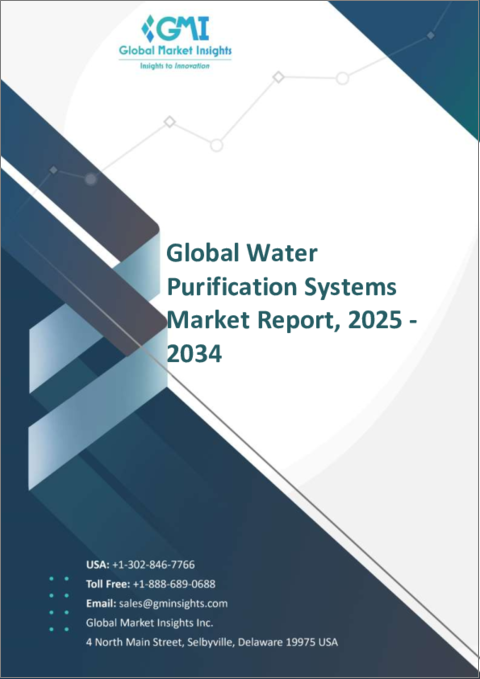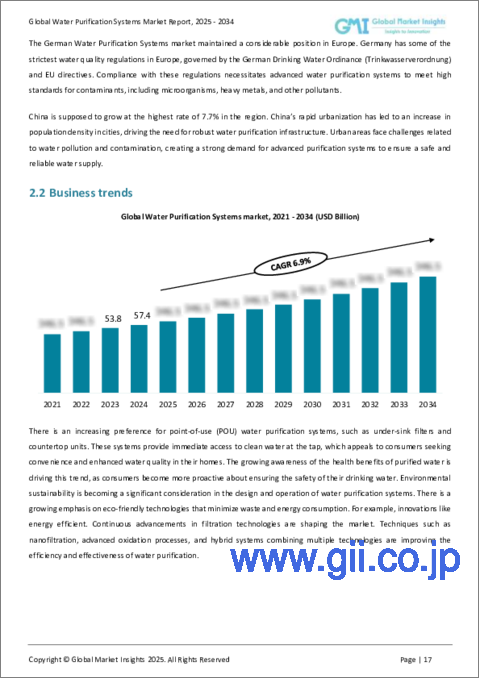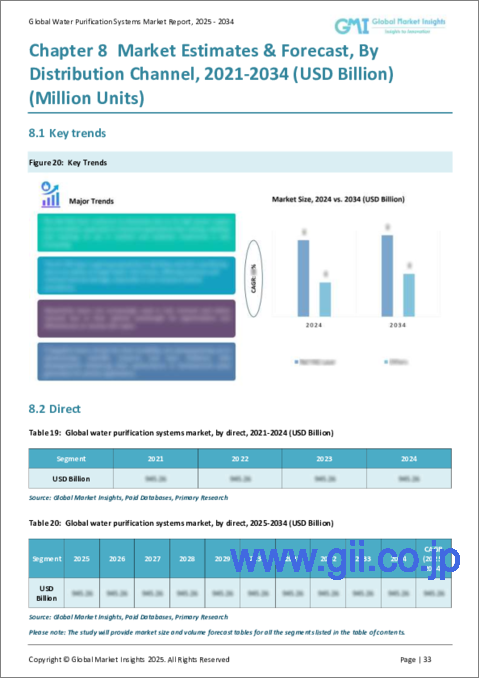|
|
市場調査レポート
商品コード
1616031
浄水システムの機会と促進要因、産業動向分析、2024年~2032年予測Water Purification Systems Market Opportunity, Growth Drivers, Industry Trend Analysis, and Forecast 2024 - 2032 |
||||||
カスタマイズ可能
|
|||||||
| 浄水システムの機会と促進要因、産業動向分析、2024年~2032年予測 |
|
出版日: 2024年09月02日
発行: Global Market Insights Inc.
ページ情報: 英文 145 Pages
納期: 2~3営業日
|
- 全表示
- 概要
- 目次
浄水システムの世界市場規模は2023年に538億米ドルとなり、予測期間中にCAGR 6.5%で拡大すると予測されています。
同市場の成長を後押ししているのは、清潔な水に対する世界の需要の高まりと、先進的水処理技術に対する緊急のニーズです。水質や汚染に対する懸念の高まりが、信頼性の高い浄化ソリューションに対する需要急増の主要要因となっています。工業化と都市化によって水源に汚染物質が混入する中、安全な飲料水を保証する先進的濾過システムが急務となっています。
その結果、先進国、開発途上国を問わず、世界各国はこれらの課題に取り組み、公衆衛生を守るため、浄水インフラに多額の投資を行っています。浄水システム産業全体は、製品、技術、最終用途、流通チャネル、地域に基づいて分類されます。市場は、製品をPOE-POUシステム、フィルター、ポータブル浄水器、中央浄水システム、その他に分類します。フィルターは2023年に221億米ドルの市場シェアを占め、2032年には409億米ドルに急増すると予測されています。その汎用性は住宅、商業、工業の各領域に及び、沈殿物、塩素、重金属などの汚染物質を除去して水質を向上させる上で極めて重要です。
POEシステムが建物の入口で水を処理するのに対し、POUシステムは特定のニーズに対応します。キャンプやハイキングのようなアウトドアレジャーの急増は、遠隔地で安全な飲料水を確保するために不可欠なポータブル浄水器の需要を増大させています。その他の市場技術には、逆浸透、活性炭濾過、紫外線(UV)浄化、蒸留、イオン交換などがあります。2023年の展望では、活性炭技術が36%の市場シェアを獲得し、継続的な成長が見込まれています。
| 市場範囲 | |
|---|---|
| 開始年 | 2023年 |
| 予測年 | 2024~2032年 |
| 開始価格 | 538億米ドル |
| 予想価格 | 952億米ドル |
| CAGR | 6.5% |
柔らかさと通気性で知られるコットンは、特に低負荷の運動や日常着として、スポーツブラの材料に好まれています。肌への刺激が少ないため、敏感肌の人にとっても魅力的です。さらに、綿のスポーツブラは合成繊維のものより低価格であることが多く、予算に敏感な消費者にとって魅力的な選択肢となっています。北米の2023年の市場評価額は約142億米ドルで、2032年には257億米ドルに達する勢いです。北米では、米国環境保護庁(EPA)やカナダ環境・気候変動省(Environment and Climate Change Canada)などの機関によって厳しい水質規制が施行されており、安全な飲料水を確保するために定期的な検査と処理が義務付けられています。このような規制は、規制遵守のための高度浄化技術の採用を促進するだけでなく、水質強化の重要性も強調しています。
目次
第1章 調査手法と調査範囲
第2章 エグゼクティブサマリー
第3章 産業洞察
- エコシステム分析
- バリューチェーンに影響を与える要因
- 利益率分析
- 変革
- 将来の展望
- メーカー
- 流通業者
- サプライヤーの状況
- 利益率分析
- 原料分析
- 主要ニュース&イニシアチブ
- 規制状況
- 影響要因
- 促進要因
- 清潔な水に対する世界の需要の増加
- 健康とウェルネスに対する意識の高まり
- 繊維技術の進歩
- 急速な都市化と工業化
- 産業の潜在的リスク・課題
- 高いイニシャルコスト
- 規制遵守
- 促進要因
- 成長可能性分析
- ポーター分析
- PESTEL分析
第4章 競合情勢
- イントロダクション
- 企業シェア分析
- 競合のポジショニングマトリックス
- 戦略展望マトリックス
第5章 市場推定・予測:製品別、2021~2032年
- 主要動向
- POE-POUシステム
- フィルター
- ポータブル浄水器
- セントラル浄水システム
- その他(従来型システムなど)
第6章 市場推定・予測:技術別、2021~2032年
- 主要動向
- 逆浸透膜
- 活性炭濾過
- 紫外線(UV)浄化
- 蒸留
- イオン交換
- その他(セラミック濾過など)
第7章 市場推定・予測:用途別、2021~2032年
- 主要動向
- 住宅用
- 商業用
- 産業用
- 自治体
第8章 市場推定・予測:流通チャネル別、2021~2032年
- 主要動向
- 直接
- 間接
第9章 市場推定・予測:地域別、2021~2032年
- 主要動向
- 北米
- 米国
- カナダ
- 欧州
- 英国
- ドイツ
- フランス
- イタリア
- スペイン
- ロシア
- その他の欧州
- アジア太平洋
- 中国
- インド
- 日本
- 韓国
- オーストラリア
- その他のアジア太平洋
- ラテンアメリカ
- ブラジル
- メキシコ
- その他のラテンアメリカ
- 中東・アフリカ
- 南アフリカ
- サウジアラビア
- アラブ首長国連邦
- その他の中東・アフリカ
第10章 企業プロファイル
- 3M Company
- Aquatech International LLC
- Calgon Carbon Corporation
- Culligan International Company
- Danaher Corporation
- Ecolab Inc.
- GE Water & Process Technologies
- H2O Innovation Inc.
- Honeywell International Inc.
- Kuraray Co., Ltd.
- Pentair PLC
- SUEZ Water Technologies & Solutions
- Veolia Environnement S.A.
- Xylem Inc.
The Global Water Purification Systems Market was valued at USD 53.8 billion in 2023 and is projected to expand at a CAGR of 6.5% during the forecast period. The market's growth is propelled by escalating global demands for clean water and the urgent need for advanced water treatment technologies. Heightened concerns over water quality and contamination are primary drivers for the surging demand for dependable purification solutions. With industrialization and urbanization introducing pollutants into water sources, there's an urgent need for advanced filtration systems to guarantee safe drinking water.
Consequently, nations worldwide, both developed and developing, are channeling significant investments into water purification infrastructures to tackle these challenges and protect public health. The overall water purification systems industry is classified based on product, technology, end-use, distribution channel, and region. The market segments its products into POE-POU systems, filters, portable purifiers, central water purification systems, and others. Filters, commanding a market share of USD 22.1 billion in 2023, are projected to soar to USD 40.9 billion by 2032. Their versatility spans residential, commercial, and industrial domains, making them pivotal in enhancing water quality by eliminating contaminants like sediment, chlorine, and heavy metals.
While POE systems treat water at the building's entry, POU systems cater to specific outlet needs. The surge in outdoor pursuits like camping and hiking has amplified the demand for portable water purifiers, vital for ensuring safe drinking water in remote locales. Market technologies include reverse osmosis, activated carbon filtration, ultraviolet (UV) purification, distillation, ion exchange, and others. Dominating the 2023 landscape, activated carbon technology captured a 36% market share and is poised for continued growth.
| Market Scope | |
|---|---|
| Start Year | 2023 |
| Forecast Year | 2024-2032 |
| Start Value | $53.8 Billion |
| Forecast Value | $95.2 Billion |
| CAGR | 6.5% |
Cotton, celebrated for its softness and breathability, is a preferred material for sports bras, especially for low-impact activities and daily wear. Its reduced likelihood of causing skin irritation makes it appealing to those with sensitivities. Moreover, with cotton sports bras often priced lower than their synthetic counterparts, they present an attractive option for budget-conscious consumers. North America, with a market valuation of approximately USD 14.2 billion in 2023, is on track to reach USD 25.7 billion by 2032. Stringent water quality regulations in North America, enforced by agencies like the U.S. Environmental Protection Agency (EPA) and Environment and Climate Change Canada, mandate regular testing and treatment to ensure safe drinking water.These regulations not only drive the adoption of advanced purification technologies for compliance but also emphasize the importance of enhancing water quality.
Table of Contents
Chapter 1 Methodology & Scope
- 1.1 Market scope & definitions
- 1.2 Base estimates & calculations
- 1.3 Forecast calculations
- 1.4 Data sources
- 1.4.1 Primary
- 1.4.2 Secondary
- 1.4.2.1 Paid sources
- 1.4.2.2 Public sources
Chapter 2 Executive Summary
- 2.1 Industry 360° synopsis, 2021-2032
Chapter 3 Industry Insights
- 3.1 Industry ecosystem analysis
- 3.1.1 Factor affecting the value chain
- 3.1.2 Profit margin analysis
- 3.1.3 Disruptions
- 3.1.4 Future outlook
- 3.1.5 Manufacturers
- 3.1.6 Distributors
- 3.2 Supplier landscape
- 3.3 Profit margin analysis
- 3.4 Raw material analysis
- 3.5 Key news & initiatives
- 3.6 Regulatory landscape
- 3.7 Impact forces
- 3.7.1 Growth drivers
- 3.7.1.1 Increasing global demand for clean water
- 3.7.1.2 Increasing health and wellness awareness
- 3.7.1.3 Advancements in textile technology
- 3.7.1.4 Rapid urbanization and industrialization
- 3.7.2 Industry pitfalls & challenges
- 3.7.2.1 High initial cost
- 3.7.2.2 Regulatory compliances
- 3.7.1 Growth drivers
- 3.8 Growth potential analysis
- 3.9 Porter's analysis
- 3.10 PESTEL analysis
Chapter 4 Competitive Landscape, 2023
- 4.1 Introduction
- 4.2 Company market share analysis
- 4.3 Competitive positioning matrix
- 4.4 Strategic outlook matrix
Chapter 5 Market Estimates & Forecast, By Product, 2021-2032 (USD Billion) (Million Units)
- 5.1 Key trends
- 5.2 POE-POU Systems
- 5.3 Filters
- 5.4 Portable Purifiers
- 5.5 Central Water Purification Systems
- 5.6 Others (Traditional systems, etc.)
Chapter 6 Market Estimates & Forecast, By Technology, 2021-2032 (USD Billion) (Million Units)
- 6.1 Key trends
- 6.2 Reverse Osmosis
- 6.3 Activated Carbon Filtration
- 6.4 Ultraviolet (UV) Purification
- 6.5 Distillation
- 6.6 Ion Exchange
- 6.7 Others (Ceramic Filtration, etc.)
Chapter 7 Market Estimates & Forecast, By En-use, 2021-2032 (USD Billion) (Million Units)
- 7.1 Key trends
- 7.2 Residential
- 7.3 Commercial
- 7.4 Industrial
- 7.5 Municipal
Chapter 8 Market Estimates & Forecast, By Distribution Channel, 2021-2032 (USD Billion) (Million Units)
- 8.1 Key trends
- 8.2 Direct
- 8.3 Indirect
Chapter 9 Market Estimates & Forecast, By Region, 2021-2032 (USD Billion) (Million Units)
- 9.1 Key trends
- 9.2 North America
- 9.2.1 U.S.
- 9.2.2 Canada
- 9.3 Europe
- 9.3.1 UK
- 9.3.2 Germany
- 9.3.3 France
- 9.3.4 Italy
- 9.3.5 Spain
- 9.3.6 Russia
- 9.3.7 Rest of Europe
- 9.4 Asia Pacific
- 9.4.1 China
- 9.4.2 India
- 9.4.3 Japan
- 9.4.4 South Korea
- 9.4.5 Australia
- 9.4.6 Rest of Asia Pacific
- 9.5 Latin America
- 9.5.1 Brazil
- 9.5.2 Mexico
- 9.5.3 Rest of Latin America
- 9.6 MEA
- 9.6.1 South Africa
- 9.6.2 Saudi Arabia
- 9.6.3 UAE
- 9.6.4 Rest of MEA
Chapter 10 Company Profiles
- 10.1 3M Company
- 10.2 Aquatech International LLC
- 10.3 Calgon Carbon Corporation
- 10.4 Culligan International Company
- 10.5 Danaher Corporation
- 10.6 Ecolab Inc.
- 10.7 GE Water & Process Technologies
- 10.8 H2O Innovation Inc.
- 10.9 Honeywell International Inc.
- 10.10 Kuraray Co., Ltd.
- 10.11 Pentair PLC
- 10.12 SUEZ Water Technologies & Solutions
- 10.13 Veolia Environnement S.A.
- 10.14 Xylem Inc.






